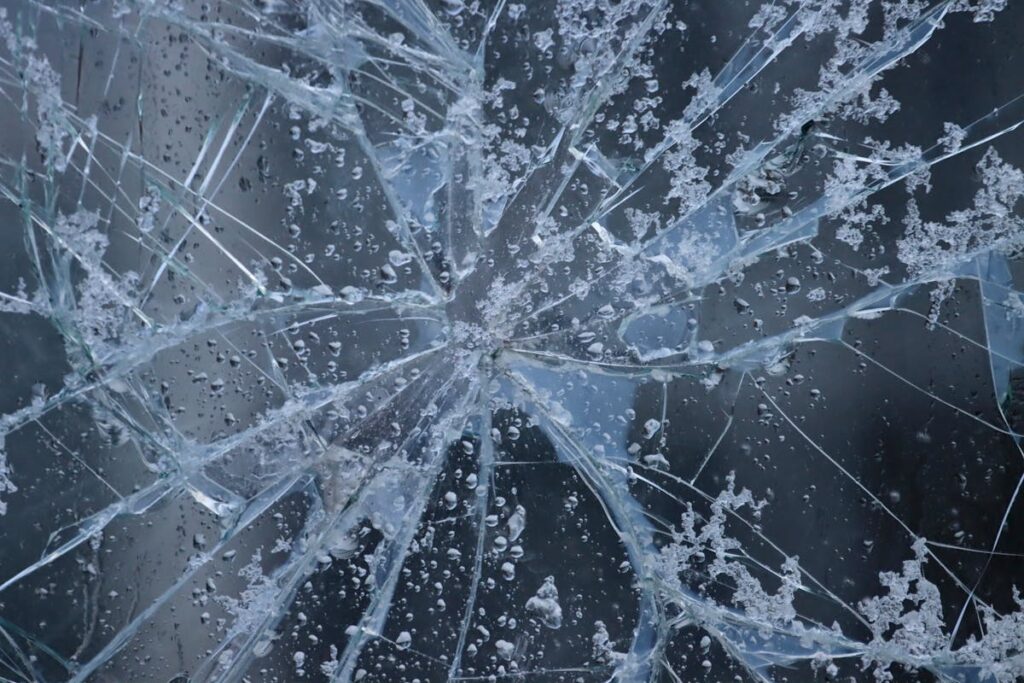The evolution of safety materials, particularly safety glass, used in various industries is a demonstration of the resilience and ingenuity of engineers and scientists in the face of catastrophic events. The advent of laminated glass and the subsequent development of materials such as Kevlar and carbon fiber have greatly altered the landscape of safety measures in the wake of major crashes. Yet, one cannot help but ponder how these advancements were influenced by the lessons learned from such tragedies and what future innovations could further enhance protective measures.
The Invention of Safety Glass
In the early 20th century, a transformative innovation occurred in the form of safety glass. This scientific breakthrough was marked by the introduction of laminated glass, a type of safety glass renowned for its shatter resistance.
Laminated glass is ingeniously structured by sandwiching a layer of plastic, typically polyvinyl butyral (PVB), between two layers of clear glass. The polymer interlayer, the PVB, plays a pivotal role in holding the entire structure together, thereby enhancing shatter resistance. This results in a significant reduction in potential injuries and fatalities from shattered glass, specifically in vehicular incidents.
Upon forceful impact, laminated safety glass behaves differently from standard glass. Instead of shattering into countless hazardous shards, it crumbles into tiny, granular chunks. This unique characteristic of laminated glass can be attributed to the strong bonding between the glass and plastic layers, rendering the glass less likely to break apart dangerously.
The advent of laminated safety glass revolutionized safety measures, particularly in the automotive and architectural industries. Its properties of shatter resistance and the ability to maintain structural integrity post-impact were instrumental in its swift adoption. The invention of safety glass marked a significant milestone in the evolution of safety materials.
How Major Crashes Spurred Innovation
Historically, major accidents have often served as catalysts for technological advancements aimed at enhancing safety. The sinking of the Titanic, for instance, led to the development and widespread use of safety glass, while aviation mishaps have given rise to the invention of black boxes. Similarly, the evolution of seatbelts can be traced back to efforts to minimize fatalities in automobile crashes.
Titanic Tragedy: Safety Glass
Emerging from the depths of the Titanic tragedy was an unsung hero – safety glass. The catastrophic loss of life, instigated by the ship’s collision with an iceberg in 1912, served as a poignant reminder of the urgent need for enhanced safety regulations and the development of materials with greater durability.
In the aftermath of the disaster, safety glass gained prominence. This innovation, also known as laminated glass, is a type of composite material made by sandwiching a layer of plastic, typically polyvinyl butyral, between two layers of glass. This construction guarantees that upon impact, the glass does not shatter into lethal shards but remains adhered to the plastic layer, reducing the risk of injury.
The introduction of safety glass in ships and other modes of transportation represented a significant leap forward in material science. It also underscored the evolution of safety regulations, which now mandated the use of such materials to protect passengers in the event of a major crash. Consequently, the Titanic tragedy indirectly spurred advances in safety technology, transforming a moment of profound loss into a catalyst for lifesaving innovation.
Aviation Accidents: Black Boxes
Without a doubt, aviation accidents have been key drivers of technological evolution in the domain of safety measures. Particularly, the advent of black box technology has transformed the analysis of such incidents, providing critical insights to prevent future disasters.
Black box technology, officially known as a Flight Data Recorder (FDR), was not widely adopted until the mid-20th century, following a series of catastrophic aviation accidents. The FDR’s ability to survive extreme conditions and preserve a record of the flight’s data was a groundbreaking innovation. This data recording device captures numerous parameters such as altitude, speed, heading, and cockpit conversations, all of which are invaluable during post-crash investigations.
Scientific analysis of data recorded in a black box has led to advancements in aircraft design, improved safety regulations, and more effective pilot training methods. For instance, patterns identified from black box data have informed changes in cockpit layout, reducing pilot error. Furthermore, the data has informed regulatory changes, including stricter maintenance protocols.
Automobile Crashes: Seatbelts Evolution
Similar to aviation, the automobile industry has also experienced its share of major crashes, each serving as catalysts for safety innovations. The evolution of seatbelts, in particular, is a striking illustration of these changes. An examination of crash statistics reveals that the introduction and enhancement of seatbelts have considerably reduced fatalities and injuries in automobile accidents.
Safety regulations were established, mandating the incorporation of seatbelts into vehicle design. These regulations were predicated on a complex impact analysis that factored in speed, collision angle, and human factors like body size and position at the moment of crash. This meticulous analytical approach led to the creation of three-point seatbelts, which distribute the energy of the occupant’s body over the chest, pelvis, and shoulders during a crash.
Accident prevention also improved with the integration of seatbelt reminder technology into vehicles, an example of effective technology integration. Additionally, education programs have played a vital role in promoting seatbelt use, further driving down crash statistics. To sum up, the evolution of seatbelts demonstrates how major crashes have spurred safety innovations, ultimately leading to enhanced accident prevention and safety in the automobile industry.
Black Box: Accident Investigation Gamechanger
The advent of the black box, a flight data recorder, has fundamentally transformed the landscape of aviation accident investigation. This device captures a thorough array of information, such as altitude, airspeed, and flight path, thereby providing invaluable insight into the circumstances leading to an aviation mishap. By examining these data, investigators can ascertain the sequence of events, pinpoint areas of failure, and formulate safety-enhancing strategies, consequently underscoring the black box’s pivotal role in enhancing aviation safety.
Black Box: Functionality
Instrumental in accident investigations, the black box, officially known as the flight data recorder, is an essential component of air travel safety. Its primary function is data recording, meticulously logging every detail of a flight’s operations. These include parameters such as altitude, airspeed, heading, vertical acceleration, and hundreds more, providing an extensive data set for crash analysis.
The black box’s structure is a demonstration of its robustness. Encased in an almost indestructible shell, it can withstand severe impacts, intense fires, and the corrosive effects of salt water. The recorded data is stored in solid-state memory boards, which are immune to crash impacts and high temperatures.
This device is equipped with an Underwater Locator Beacon that emits a signal if submerged in water, aiding in the retrieval of the black box in the unfortunate event of a water crash. The information extracted from the black box aids investigators in piecing together the sequence of events leading up to a crash. Consequently, it allows for a scientific, analytical approach to accident investigation, turning it from a game of guesswork into a methodical process.
Impact on Aviation Safety
How has the advent of the black box revolutionized aviation safety? Fundamentally, it has fostered an environment of continual improvement in numerous areas.
Firstly, analysis of black box data has markedly improved pilot behavior. By providing tangible evidence of actions taken during an emergency, it has refined emergency protocols and training programs. This has led to superior decision-making processes in high-stress situations.
Secondly, the black box has raised maintenance standards by revealing mechanical flaws that may have contributed to incidents. This has prompted more rigorous safety regulations and checks, particularly in cargo handling and technology integration.
Furthermore, the black box has influenced runway design. Information gathered about take-off and landing incidents has guided the construction of safer, more efficient runways.
Flame-Retardant Materials: Fireproofing the Future

Advancements in flame-retardant materials herald a new era in safety technology, offering unprecedented protection against the devastating impacts of fire. This branch of material innovation aims to prevent or slow the spread of flames, thereby mitigating the potential for catastrophic damage and loss of life.
The science behind flame resistance is complex, involving intricate chemical processes. When exposed to high temperatures, these materials either reduce the rate of heat release or form a protective layer that inhibits the combustion process. This delay in flame propagation can provide valuable time for evacuation and fire control measures, substantially increasing survival rates during fire incidents.
Research and development in this field have led to the creation of various types of flame-retardant materials. From inherently flame-resistant fabrics to treated materials that gain fire resistance through chemical additives, each has its specific applications and advantages. These materials now pervade many aspects of modern life, from the clothes we wear to the furnishings in our homes and the interiors of our vehicles.
Promising developments continue in this sphere, with the focus on improving flame resistance, reducing toxicity, and enhancing the durability of these materials. The future of safety may indeed be fireproof, thanks to these innovations.
The Evolution of Crash Helmets
Just as flame-retardant materials have revolutionized safety in the event of fires, crash helmets have undergone a significant evolution to protect individuals during high-impact incidents. Early versions were primarily composed of leather, offering little protection against severe trauma. However, the advent of polystyrene foam in the 1960s marked a significant leap in helmet technology, providing enhanced impact absorption.
This helmet technology has gradually evolved, incorporating materials such as Kevlar and carbon fiber for their high strength-to-weight ratios. The modern helmet is composed of an outer shell designed to distribute the force of an impact, a layer of EPS foam to absorb the shock, and an inner comfort layer. The outer shell is typically made of polycarbonate, fiberglass, or carbon fiber, each offering different levels of protection and weight.
The development of Multi-directional Impact Protection System (MIPS) has also greatly enhanced helmet safety. This design allows the helmet to rotate slightly upon impact, reducing rotational forces which can cause brain injuries.
Seatbelts: Lifesaving Straps
Undeniably, seatbelts have played a vital role in ensuring passenger safety during vehicular accidents. Safety regulations worldwide mandate their usage, and crash statistics consistently affirm their life-preserving potential.
Fundamentally, a seatbelt’s role is to arrest momentum during a sudden halt or impact, reducing the risk of collision between the occupant and the vehicle’s interior, and preventing ejection from the vehicle. A three-point seatbelt, the most common type, applies restraining forces to the chest and pelvis- strong areas of the human body- thereby minimizing injury.
Scientifically, the effectiveness of seatbelts is a matter of physics, specifically Newton’s First Law of Motion. The abrupt stop of a vehicle during a crash creates a forceful forward thrust for its passengers. Seatbelts provide a counteracting force, markedly reducing the risk of fatal injury.
Crash statistics underscore the importance of seatbelts. According to the National Highway Traffic Safety Administration, seatbelts saved approximately 14,955 lives in the United States in 2017 alone. Despite such compelling data, compliance with safety regulations regarding seatbelt usage remains suboptimal, indicating a continued need for public education on this lifesaving strap’s essential role.
Breakthroughs in Aircraft Materials
Over the past decades, there has been a surge in the development and application of revolutionary materials in aircraft manufacturing. The goal has been to find the right balance between weight, strength, and durability while keeping safety paramount. Among these, aerospace composites have emerged as a standout material.
Aerospace composites, usually carbon-fiber reinforced polymers, offer significant advantages over traditional materials like aluminum. They are lighter, stronger, and more resistant to environmental conditions, improving fuel efficiency and reducing maintenance costs. In addition, these composites can be molded into complex shapes, allowing aerodynamic designs that aren’t possible with metal.
However, the use of these composites has brought new challenges. Unlike metals, they don’t exhibit visible signs of damage, making inspections more essential and complex. Additionally, they are less heat-resistant than metals, which can impact safety in case of fire.
Meanwhile, the focus on lightweight structures has led to innovations like honeycomb panels. These panels, composed of thin sheets of material forming a honeycomb pattern, provide excellent strength-to-weight ratio, further reducing aircraft weight without compromising safety.
These breakthroughs have certainly enhanced aircraft safety, but they also underscore the importance of ongoing research and refinement in this vital field.
Future Directions in Crash-Safety Materials
As we peer into the future of crash-safety materials, it becomes increasingly evident that the focus is shifting towards smart materials and innovative designs. These new materials, often considered as the vanguard of safety technology, possess unique properties that enable them to adapt and respond to different environmental conditions and impacts.
Smart materials, for instance, can change their physical properties such as shape, stiffness, and viscosity in response to external stimuli, offering unprecedented levels of protection. Shape-memory alloys and piezoelectric materials are two notable examples, the former with its ability to return to a pre-set shape after deformation, and the latter converting mechanical stress into electrical energy, which could potentially be harnessed for additional safety features.
The future also looks promising for bioengineered composites, a new class of materials synthesized using biological processes. They offer exceptional strength and lightweight attributes while being highly customizable, paving the way for personalized safety gear. For example, spider silk, a bioengineered composite, is known for its extreme toughness and elasticity, properties that could be exploited for next-generation crash-safety applications.
Frequently Asked Questions
How Are Safety Tests for These Materials Conducted?
Safety material tests are conducted through stringent impact analysis procedures. These testing protocols involve subjecting the materials to simulated crash scenarios, evaluating their resistance, durability, and ability to protect against potential hazards.
What Is the Lifespan of These Crash-Safety Materials?
The lifespan of crash-safety materials demonstrates variability, as it greatly depends on factors like usage and environmental conditions. However, with ideal conditions, material durability can extend several years, ensuring long-term protection and performance.
Are These Safety Inventions Cost-Effective for Manufacturing Companies?
Cost-effectiveness of safety inventions largely depends on detailed cost analysis and manufacturing efficiency. While initial production costs may be high, long-term benefits, such as reduced liability and enhanced reputation, often outweigh the upfront investment.
What Are the Environmental Impacts of Producing These Safety Materials?
The production of safety materials can have environmental implications. However, with proper recycling processes and sustainability practices, the environmental footprint can be considerably reduced, ensuring a balance between safety and environmental conservation.
Are There Any Drawbacks or Risks Associated With These Safety Materials?
While safety materials markedly increase protection, potential drawbacks include compromised material durability over time and, in some cases, reduced user comfort due to rigidity or weight of the materials. Continuous research is required to mitigate these issues.

